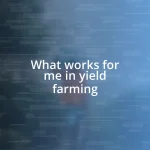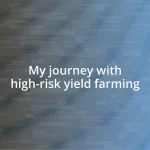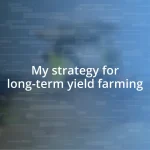Key takeaways:
- Yield farming involves providing liquidity to DeFi protocols for rewards, emphasizing the need for informed decision-making regarding platform choice and risk tolerance.
- Maximizing gains requires active management, such as diversifying investments, reinvesting rewards, and staying updated on market trends.
- Effective risk management includes setting profit-taking strategies, regularly reassessing portfolios, and maintaining emotional control to mitigate impulsive decisions.

Understanding Yield Farming Basics
Yield farming might sound complex, but at its core, it’s about putting your cryptocurrency to work to earn more crypto. I remember my first foray into yield farming; it felt akin to tending a garden – nourishing my assets and watching them grow over time. This process usually involves providing liquidity to decentralized finance (DeFi) protocols in exchange for rewards, which can vary widely from one project to another.
One thing that often surprises newcomers is the sheer variety of platforms available for yield farming. I felt overwhelmed by choices at first; should I use an established protocol or take a risk on a newer one? Each decision carries different levels of risk and reward, and understanding how each platform operates is crucial. Diving deep into the project details, like the smart contracts they use, helped clarify potential pitfalls, and trust me, being informed can save you from unexpected losses.
As you engage in yield farming, consider how the potential rewards align with your risk tolerance. I vividly recall the excitement—and anxiety—of watching the early gains trickle in, realizing my decisions could lead to significant profits or losses. Ask yourself: What are you comfortable risking? This reflection can guide your choices and help balance your ambitions with the realities of the market.

Choosing the Right Platform
Choosing the right platform for yield farming is a pivotal step that significantly impacts your overall gains. When I was starting out, I quickly learned that not all platforms offer the same level of security or reward potential. I remember opting for a platform that was well-reviewed, only to later discover it had hidden fees that ate into my profits. It’s essential to not just skim through user reviews but to delve into the community sentiment and platform transparency.
Moreover, I felt it was critical to assess how each platform aligns with my investment strategy. Do you prefer higher risks for potentially higher rewards, or are you more inclined toward stability? On one occasion, I opted for a lesser-known platform that promised high returns. Initially, I was ecstatic watching my assets grow, but that excitement swiftly turned to dread when the platform faced a liquidity crisis, leading to unforeseen losses. That experience taught me the significance of researching the underlying mechanics of a platform’s operations, as well as its market reputation.
To make an informed decision, it’s helpful to evaluate various platforms based on specific criteria. Below is a comparison table that highlights essential factors to consider when choosing your yield farming platform:
| Platform Name | Security Features | Fees | Potential Returns |
|---|---|---|---|
| Platform A | Audited smart contracts | Low | 5-15% |
| Platform B | Community-reviewed | Moderate | 10-20% |
| Platform C | No audits yet | High | 15-30% |

Strategies for Maximizing Gains
Maximizing gains in yield farming is more than just picking the right platform; it demands a well-rounded strategy that encompasses active management and market awareness. When I first dove into this world, I realized that staying informed about market trends can make or break your farming experience. I remember frantically checking price fluctuations and news updates during my early days. It’s both thrilling and nerve-wracking to see good investments swing wildly, but emotional control is key.
Here are some strategies that have worked well for me in boosting my yield farming gains:
- Diversify Investments: Spread your investments across multiple assets to mitigate risk.
- Reinvest Rewards: Consider compounding your gains by reinvesting the rewards.
- Monitor Gas Fees: High transaction costs can eat into profits; find the best times to transact.
- Stay Updated: Follow project developments and market news to make informed decisions.
- Utilize Analytics Tools: Leverage analytics platforms to track performance and optimize yield farming strategies.
I’ve found that each of these approaches has not only helped increase my yields but also instilled a greater sense of confidence in my overall strategy.

Risk Management Techniques
Effective risk management is an essential part of yield farming that can often feel daunting. I remember my first foray into this space where I was overwhelmed with the choices, but a valuable lesson came from a near miss. One of my investments spiked just before a major market downturn, and I hesitated to exit. Imagining my potential losses was nerve-wracking, but it prompted me to adopt a strategy of setting stop-loss orders, which has since saved me from larger downtrends.
One technique I swear by is regularly reassessing my portfolio. It’s like giving my investments a health check. I’ll sit down with a cup of coffee, review my holdings, and ask myself, “Are they still performing as expected?” This periodic evaluation helps me identify underperforming assets before they consume significant portions of my profits. In one instance, I noticed an asset that had been bullish for weeks suddenly plateauing. By reallocating that capital into more promising opportunities, I managed to keep my overall gains on track.
I also make it a point to keep my emotions in check. Yield farming can create intense highs and lows, and I’ve learned that emotional trading often leads to impulsive decisions. During a particularly volatile phase, I once let fear push me into liquidating my holdings too early. The regret lingered long after; if only I had stuck to my strategy! Now, I set clear parameters for buying and selling that help contain my emotional responses. How do you manage the emotional rollercoaster? I find a disciplined approach, combined with well-placed breaks, usually does the trick.

Monitoring and Adjusting Positions
To maximize my yield farming gains, monitoring and adjusting positions has become an essential practice. I remember a time when I was overly confident in a liquidity pool, convinced it would keep climbing. But then I noticed subtle warning signs—trading volume dwindling and community sentiment shifting. These indicators urged me to reassess my position. I can’t emphasize enough how crucial it is to keep an attentive eye on these factors; they often provide the early warning needed to protect hard-earned gains.
Adjusting positions isn’t just reactive; it’s also a proactive strategy. I regularly update my asset allocations based on ongoing performance reviews. During one particularly volatile market phase, I took the time each weekend to analyze my holdings—embracing a more hands-on approach allowed me to reposition funds into higher-performing pools. You might ask yourself, “How often should I check my investments?” Personally, I’ve found that dedicating a few hours weekly to this process makes a significant difference in staying in tune with the market.
In essence, I treat monitoring my positions like a dynamic balancing act. I once faced a scenario where I hesitated to pull funds from an asset that had become stagnant, thinking it would bounce back. Eventually, realization hit me: I was allowing my emotions to dictate my decisions. Once I adjusted my strategy to embrace swift actions instead of hesitation, I found not only greater stability but also improved overall yields. Monitoring and adjusting is about cultivating an agile mindset. How agile are you in your investments? Adopting this mentality can lead to finding opportunities where others see challenges.

Taking Profits Effectively
Taking profits effectively is a skill I’ve honed over time, shaped by both success and missteps. I vividly recall a moment when I watched a project I had heavily invested in soar rapidly. Instead of taking a portion of my profits, I held out for more, thinking it would continue its upward trajectory. The market corrected, and I felt that familiar knot of anxiety as my gains evaporated. Now, I prioritize setting specific profit-taking points at the outset. This approach allows me to lock in gains while still participating in potential upsides without the weight of fear holding me back.
One technique that’s transformed my profit-taking strategy is the use of tiered exit points. I often break my investments into chunks, deciding in advance what percentage I will sell at different price levels. I remember once holding a token that doubled in value overnight. Instead of going all-in for a sell, I cashed out 25%, then 25% again at a higher price. This not only provided instant cash flow but also eased my worries about possible downturns. Have you ever experienced that rush of uncertainty as profits mount? Tiered exits help manage that fluctuation, allowing me to celebrate wins without overexposure.
Lastly, I’ve learned to embrace the concept of “profit harvesting.” This practice doesn’t just mean seizing gains; it’s about using profits to reinvest in new opportunities. I once sold a significant portion of a fading asset and used those funds to explore emerging projects with strong fundamentals. Considering your options, how often do you think about reallocating your gains? For me, profit harvesting not only secures my initial investments but also keeps my portfolio vibrant and growing, ensuring I capitalize on new potential while keeping the old faith alive.














